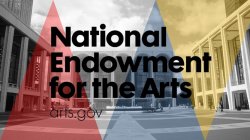My debt to the National Endowment for the Arts – by Neil Baldwin
Posted in: Director's Essay

Today is the first day of Arts Advocacy Week and the timing is propitious: a chance to raise our voices and protest the proposed elimination of The National Endowment for the Arts (NEA). And the place is perfect: Montclair State University, a public educational institution where the arts matter, truly and deeply.
For my part, having led an Arts Advocacy life, I am moved to revive some affectionate memories about the NEA –and how, during its first decade as a new federal agency, its financial assistance enabled me to make my mark as an emerging poet.
Yes, you read that right: poet.
In June, 1973, I received my PhD in Modern American Poetry from the State University of New York at Buffalo. My mentor, the great Robert Creeley, wrote the preface for my dissertation, a descriptive catalogue of the manuscripts and letters of William Carlos Williams. I began to send out my own poems, and translations from French verse, and, after enough of my work was published in the so-called “little” magazines, I brought forth a slender letterpress poetry collection with the Salt Works Press.
Most thrilling of all, I launched a three-year career as an itinerant teacher in a program called New York State Poets-in-the-Schools. I got up each morning bright and early in my little apartment in downtown Buffalo, made a cup of coffee (Starbucks hadn’t been invented), gathered my looseleaf notebooks and box of chalk and well-thumbed copies of various poetry anthologies, stuffed them into my satchel, jumped into my car — and drove.
My travels would take me to the inner city one day, a sprawling K-12 suburban campus on another, and, farther afield, fifty miles due north, to the midst of windswept, snow-crusted farmlands where the rural district school building stood like a fortress.
This long-haired, skinny, wire-rimmed glasses wearing, language-obsessed, earnest young fellow in his twenties – that’s me — striding around like an adrenaline-fuelled, idealistic minstrel (“Here comes the poetry man!”), inspired kids to write down their earliest memories, a dream they had last night, a few lines about their favorite animal, what it felt like when their grandmother got sick, or the first time they spent a weekend away from home. Then we read them aloud and tacked them to the bulletin board.
I actually had a paying job as a working poet. Thanks to funding received by the New York State Council on the Arts from the National Endowment for the Arts, I made $75 a day. Moreover, the literary magazines with stapled bindings and mimeographed pages that published my early poems, the independent press that brought forth my slim volume of verse, and the poetry magazine I edited and published all thrived, thanks to grants by The Coordinating Council of Literary Magazines and Small Presses; the writing workshops I taught at prisons, senior citizen centers, daycare centers, and psychiatric hospitals were subsidized by Poets & Writers, Inc.; and residencies in the NYC public school system were underwritten by Teachers & Writers Collaborative.
All of these visionary presenting and regranting organizations came to life through the generosity of the Literature Program of the NEA.
I have read the economic-impact success stories and the voluminous economic studies attesting to the millions of tourist and employment dollars exponentially generated by the vast institutional nonprofit sector and the culture industry. Thanks to the leveraging impact of federal funding, the arts in America have always been an engine for growth.
However, today I express my personal indebtedness as just one author and teacher whose writing life was given its initial imprimatur of support by the National Endowment for the Arts; and to remind my readers that we need the NEA, now more than ever, to make investments that will inspire the next generation of our young artists during these troubling times.
- Neil Baldwin, cultural historian and critic, is Professor of Theatre & Dance and Director of The Creative Research Center in the College of the Arts at Montclair State University (NJ). He is currently working on a biography of Martha Graham.
